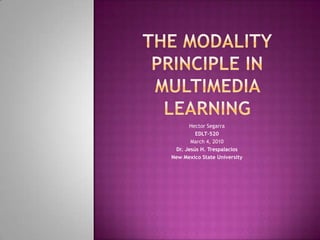
The modality principle in multimedia learning edlt 520
- 1. TheModalityPrinciple in Multimedia Learning HectorSegarra EDLT-520 March 4, 2010 Dr. Jesús H. Trespalacios New Mexico State University
- 2. Review from Previous chapters According to Mayer’s model of meaningful learning, the learnerprocesses a visual information processing system and a verbal information processing. Hence narration goes into the verbal system where animation goes into the visual system.
- 3. cognitive processes Selecting Organizing Integrating
- 4. Selecting Is applied to incoming verbal information to yield a text base and is applied to incoming visual information to yield an image base.
- 5. Organizing Is applied to the image base to create a verbally-based model of the to-be explained system and is applied to the image base to create a visually-based model of the to-be explained system.
- 6. Integrating Occurs when the learner builds connections between corresponding events (or states or parts) in the verbally-based model and the visually-based model.
- 7. Multiple Representation Principle Establish that its is better to present an explanation in words and pictures that solely in words.
- 8. Contiguity Principle When giving a multimedia explanation, present corresponding words and picture contiguously rather than separately.
- 9. Split Attention Principle When giving a multimedia explanation, present words as auditory narration rather than as visual on screen text.
- 10. Individual Differences Principle The foregoing principles are more important for low-knowledge than high-knowledge learners, and for high-spatial rather than low spatial learners.
- 11. Coherence Principle When giving a multimedia explanation, use few rather than any extraneous words and picture.
- 12. How Information isPresented “Thereisevidencetoindicatethatthemanner in wichinformationispresentedwillaffecthowwellitislearned and remember”. (Richard E. Mayer, 2005; 147) Presentingsomeinformation in visual mode and information in auditorymode can expandeffectiveworkingmemorycapacity and so reduce theeffects of anexcessivecognotive load.
- 13. Modality Principle Students learn better when the associated statements are narrated rather than presented visually. Split- attention effects-the two sources of information are still presented visually but in physically integrate form. Modality effect-written statements are converted to spoken statements.
- 14. Cognitive Load Theory and theModalityEffect According to cognitive load theory, many instructional materials and techniques may be ineffectivebecause they ignore the limitations of human working memory and impose a heavy cognitive load.
- 15. ways in which extreneous cognitive load can be manipulated Instructional procedures can alleviate extraneous cognitive load by formatting instructional material in such a way that minimizes cognitive activities that are unnecessary to learning so that cognitive resources can be freed to concentrate on essential activities. The consequences of extraneous cognitive load can also be alleviated by increasing effective working memory capacity.
- 16. Split-AttentionEffect Occurs when two or more sources of visual information must be processed simultaneously in order to derive meaning from material.
- 17. Split-Attenttion Effect (Cont.) To obtain the split-attention effect, the two visual separated sources of information are physically integrated to reduce the need for mental integration.
- 18. Modality Effect To obtain the modality effect, verbal material is presented when such dual-mode presentation is superior to a visual-only, split-attention presentation.
- 19. The Modality Effect (Cont.) The modality effect can be explained by acribing memory load to each of the treatment condition, the diagram (or picture) with text presentation induces a higher both sources of information are processed in the systems.
- 20. conclusions Effectiveworkingmemorycapacitymaybeincreased and thisincrease can beusedto reduce cognitive load and facilitatelearning. Under split-attention conditions, learning may be facilitated by presenting a written source of information in auditory mode.
- 21. References Richard E. Mayer (2005). Multimedia Learning. Santa Barbara:CambridgeUniversityPress. http://www.unm.edu/~moreno/PDFS/chi.pdf
- 22. Video Multimedia Learning Video Questions for Chapter 9: 1) What is the modality effect or modality principle? 2) Describe the two ways in which extraneous cognitive load can be manipulated. 3) Briefly summarize the findings of at least three studies looking at the effectiveness of the modality effect. 4) Define the split-attention effect. 5) What needs to happen in order for the split-attention effect to occur? 6) Summarize the main conclusions of this chapter?